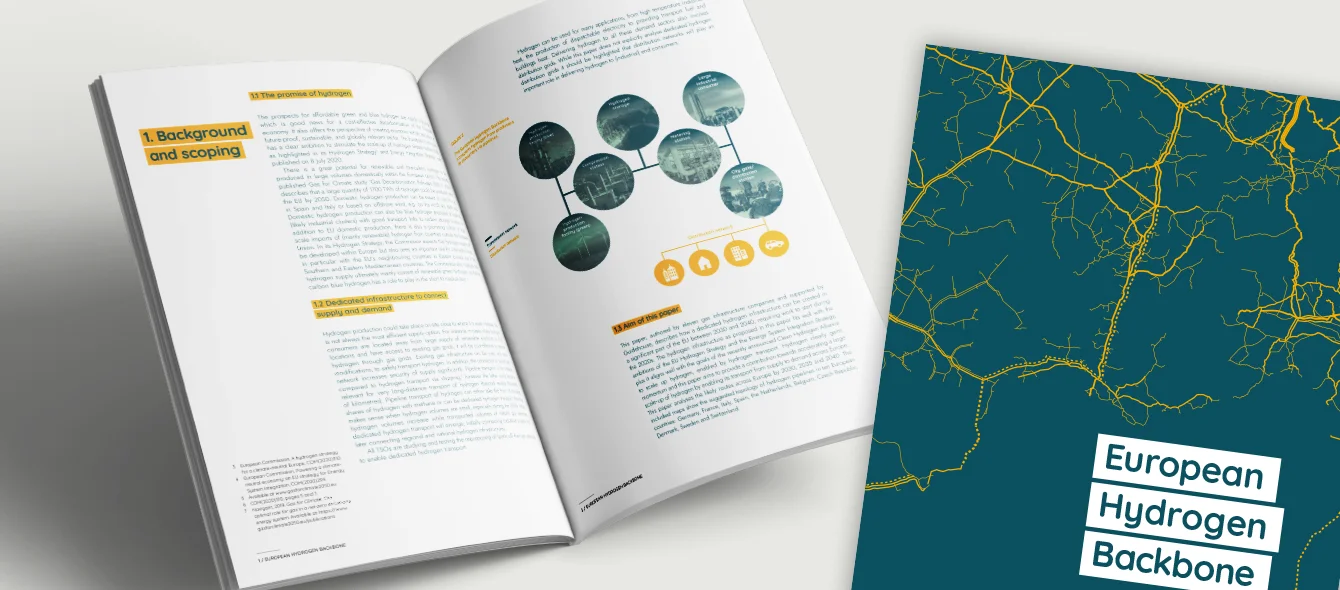The newest hydrogen hype: Before the decade is up, a ‘European hydrogen backbone’ could be supplying large swathes of the European continent with green hydrogen – a move that would drive the energy transition forward. The first ten countries are to be connected via a pipeline network of mainly pre-existing pipelines by 2030. In its position paper titled “European Hydrogen Backbone”, the strategic management consultancy firm Guidehouse, together with eleven gas network operators, gives readers a first glimpse of what this network could look like, and en:former has summarised the most important points in the following article.
Green hydrogen produced using wind and solar energy is key to the EU’s climate protection strategy. And if the European Union is to hit its target of carbon neutrality by 2050, this zero-net-carbon chemical will be integral, both from an energy storage perspective and as a fuel. However, in order to reliably cover demand from industry and the transport sector alike, there needs to be a transport and storage infrastructure.
A network of pipelines and electrolysers
This is exactly where Guidehouse’s position paper comes in. Its writers are proposing the construction of a hydrogen highway of sorts: 6,800 kilometres of pipelines are to connect Germany, France, Italy, Spain, the Netherlands, Belgium, the Czech Republic, Denmark, Sweden and Switzerland by 2030.
First, the existing natural gas pipelines of Enagás, Energinet, Fluxys Belgium, Gasunie, GRTgaz, NET4GAS, OGE, ONTRAS, Snam, Swedegas and Teréga have to be converted to transport hydrogen. Additional pipelines would also have to be built to help close any gaps between the converted pipelines. According to the position paper, by 2040 around 75 percent of the hydrogen pipeline network, which would then already be 23,000 kilometres long, could consist of converted natural gas pipelines. These would be fed by storage facilities and electrolysers, producing the gas with renewable electricity, located en-route.
By using existing lines, customers, who are already connected to the gas network, could switch to using hydrogen easily, despite a possible lack of renewables-based hydrogen electrolysis plants in the area. For, according to the position paper, the fuel can be transported efficiently over longer distances.
Parallel lines
According to the management consultancy firm, this proposed vision could soon become a reality and planning could be underway as soon as the early 2020s. In a first step, natural gas pipelines in the Netherlands, Germany, France, Spain and Italy would be converted to hydrogen pipelines. Conversion would reduce the costs of expansion significantly, compared to previous calculations.
Each of these pipelines could transport hydrogen to the tune of seven to 13 gigawatts across Europe. Although the fuel has a much lower energy density than natural gas, it can be transported with a higher flow rate, making the transported energy capacity similar to that of ordinary pipelines.
Network expands together with production
In light of the projected rapid rise in production, which could reach 100 TWh by 2030, the pipeline network could then be expanded again in a second and third phase. Even countries that are not yet involved in the plans could then be connected to the supply lines. This would mean electrolysers, powered using electricity generated by large offshore wind farms in the North Sea, could also be connected. In this way, 450 TWh of green hydrogen could be transported annually across Europe by 2050. According to the authors, the project would use 75 percent converted natural gas pipelines connected by 25 percent new pipeline stretches, and between 27 and 64 billion euros would need to be invested by 2040. Sixty percent of the costs would cover the expansion and conversion of the pipelines and the rest would be spent on compressors. Not only are these costs “relatively limited in the overall context of the European energy transition”, but they are also significantly lower than previous rough estimates for this type of project.
Photo credit: Guidehouse
